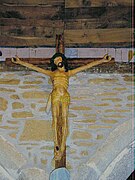The Yellow Christ
| The Yellow Christ | |
|---|---|
Albright-Knox Art Gallery |
The Yellow Christ (in French: Le Christ jaune) is a painting executed by Paul Gauguin in 1889 in Pont-Aven. Together with The Green Christ, it is considered to be one of the key works of Symbolism in symbolic mythological paintings of the older era as represented by Symbolism.
Gauguin first visited Pont-Aven in 1886. He returned to the village in early 1888 to stay until mid-October, when he left to join Vincent van Gogh in Arles, for little more than two months. Early in 1889, Gauguin was back to Pont-Aven to stay there until spring 1890. It was only for a short visit in summer 1889 to Paris to see the Exposition universelle and to arrange the Volpini Exhibition that Gauguin interrupted this sojourn. Soon after his return to Pont-Aven he painted The Yellow Christ.
The painting is a symbolic piece that shows the crucifixion of
A study for The Yellow Christ in pencil is preserved in the Thyssen-Bornemisza Museum, and a version in watercolor is in the collection of the Art Institute of Chicago, gift of Elizabeth F. Chapman.[1]
Gallery
References
- ^ "Art Institute of Chicago". Retrieved 19 July 2014.
- Gauguin et le Christ jaune, Musée de Pont-Aven, (24 June - 2 October) 2000 ISBN 2-910128-21-0


